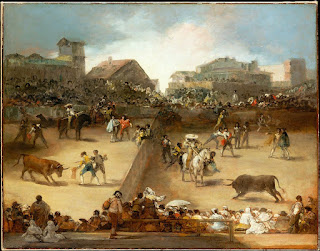Posted on March 29, 2022
This is an update of my post published on March 29, 2011:
What happens to a great big river and a mighty waterfall when ice floes block the water?
The water flow of Niagara River was stopped for a bit more than a day in 1848! Several days of harsh winds had pushed all the ice floes into a jammed-up glob at the mouth of the Niagara River - and that ice-jam became an actual dam. The enormous river was reduced to just a trickle, all the way from Buffalo to the Falls.
A farmer taking a walk around midnight first discovered that the Falls weren't...falling. He made the discovery because the usual roar of the Falls was silent. Mills that were powered by the falling water had ground to a halt. Fish died. Turtles were stranded.
 |
The U.S. Army Corps of Engineers "dewatered"
the American Falls in the 1960s, and this photo
gives us an idea of what people saw on this date
in 1848. |
Thousands of people came to the river banks to see...the unfamiliar, bare riverbed! Some people dared to walk out onto that riverbed and recover things such as old tools and weapons.
Even the soldiers in the U.S. Calvary couldn't resist riding their horses up and down the mostly empty riverbed.
And the folks who ran the Maid of the Mist tourist boats took advantage of the unexpected situation to blast some of the most dangerous rocks in the gorge!
But when the wind shifted, on the night of March 31, the ice dam way up river broke, and a wall of water came downriver and over the brink of the falls! Yikes! Apparently nobody drowned - I gather that nobody was still in the riverbed when the Falls resumed falling. Either the roar of the rushing water was audible for miles, or nobody wanted to continue frolicking on the riverbed during nighttime!
More nature + ice = daring (or foolish) behavior!
 |
This is an "ice bridge"
under Rainbow Bridge. |
Apparently “ice bridges” sometimes form on the Niagara River, below the Falls, during really long, cold winters. Until 1912, visitors were allowed to actually walk out on the ice bridge and view the Falls, but in 1912 the ice bridge broke up and three tourists died.
Did you know...?
- The Niagara Falls are 176 feet high (but there are rocks at the base, so the fall is just 70 feet), and an amazing 150,000 U.S. gallons of water pound down the Falls EVERY SECOND!!!
- There are two hydroelectric plants that harness power from some of this falling water to make electricity.
- About 12 million visitors view the Niagara Falls every year.
To build your own waterfall, try the instructions found here.
Anniversary of the discovery of an army
Plan ahead:
Check out my Pinterest boards for:
And here are my Pinterest boards for:



















































